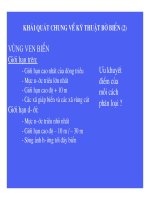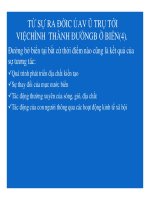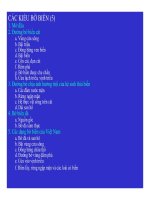Bài giảng cơ sở kỹ thuật ánh sáng Nguyễn Thanh Phương
Bạn đang xem bản rút gọn của tài liệu. Xem và tải ngay bản đầy đủ của tài liệu tại đây (27.89 MB, 139 trang )
3/21/17
CƠ SỞ KỸ THUẬT
ÁNH SÁNG
TS. Nguyễn Thanh Phương
Bộ môn Quang học và Quang điện tử
Chương 1
Những khái niệm cơ bản về ánh sáng
I.1. Lịch sử phát triển của KTAS.
2
1
3/21/17
I.1. Lịch sử phát triển của KTAS.
3
I.1. Lịch sử phát triển của KTAS.
4
2
3/21/17
I.1. Lịch sử phát triển của KTAS.
5
Chương 1
Những khái niệm cơ bản về ánh sáng
I.1. Lịch sử phát triển của KTAS.
I.2. Khái niệm về ánh sáng.
6
3
3/21/17
I.2. Khái niệm về ánh sáng.
Ánh sáng là g ì?
Sóng?
Hạt?
7
A long time ago ……
n
Aristotle (384 - 322 B.C.), an ancient Greek thinker, thought
that we saw the world by sending “something” out of our eye
and that reflected from the object.
n
In Plato’s time (427 – 347 B.C.), the reflection of light from
smooth surfaces was known. He was also a Greek.
n
The ancient Greeks (about 200 A.D.) also first observed the
refraction of light which occurs at the boundary of two
transparent media of different refractive indices.
8
4
3/21/17
Thế kỷ 17, hai nhà khoa học đưa ra hai quan điểm
khác nhau về ánh sáng tự nhiên……
Ánh sáng
là hạt
Không!
Ánh sáng
là sóng
Isaac Newton
1643 - 1727
Christian Huygens
1629 - 1695
9
In the 17th century, some p roperties o f light were
well known already. F or example:
n
Light has different c olours.
n
Light can travel through a vacuum.
n
Light can be reflected and refracted, these
processes are described by the Laws of Reflection
and Laws of Refraction.
10
5
3/21/17
Laws of Reflection
n
According to the L aws o f Reflection,
angle of incidence = angle of reflection (θi = θr )
Incident light ray
Reflected light ray
Normal
θi
θr
11
Laws of Refraction
n
Willebrord Snell discovered in 1621 that when a wave
travels from a medium of refractive index, n1 , to one of
different refractive index, n2 ,
n1sin(θ1) = n2sin(θ2)
This relationship is c alled Snell’s Law
Incident light ray
Normal
θ1
n1
Interface
n2
Light bends towards the normal when it
travels from an optically l ess dense medium
to an optically more dense medium.
θ2
Refracted light ray
12
6
3/21/17
Newton proposed his “particle theory of light”
(or “corpuscular theory of light”) to explain
the characteristics of light.
(source: “Opticks”, published by Isaac Newton in 1704)
I think light is a stream of tiny
particles, called Corpuscles …
13
Particle Theory
Why does light have different colours?
n
The particles of different c olours have
different properties, such as mass, s ize
and speed.
Why can light travel through a vacuum?
n
Light, being particles, c an naturally pass through
vacuum. (At Newton’s time, no known wave could
travel through a vacuum.)
14
7
3/21/17
Why does light travel in straight lines?
n
A ball thrown into space follows a c urved path
because of gravity.
n
Yet if the ball is thrown with greater and greater
speed, its path c urves less and less.
n
Thus, billions of tiny light particles of extremely low
mass t ravelling at enormous speeds will have paths
which are essentially s traight lines.
15
How does the particle theory explain
the Laws of Reflection?
n
The rebounding of a steel ball from
a smooth plate is s imilar to the
reflection of light from the
surface of a mirror.
Steel Ball
Many light
particles i n a light r ay
Light
Rebound
Reflection
Mirror
16
8
3/21/17
How does Newton's particle theory explain the Laws of
Refraction?
n
A cannon ball hits the surface of water, it is acted upon by a
“refracting” force which is perpendicular to the water surface.
It therefore slows down and bends away from the normal.
Light does the opposite. Newton explained this observation
by assuming that light travels faster in water, so it bends
towards the normal.
(What was the problem in this explanation?)
n
The problem:
Does light really travel
faster in water?
In fact n obody could measure
the speed o f light a t the time o f
Newton a nd Huygens
Air
Cannon ball
Water
Light
17
Why does a prism separates a beam of
white light into the colours of the rainbow?
Why does red light refract least and violet
light refract most?
Newton’s assumptions:
1. The light particles of different colours have mass.
Red light particles have more mass than violet particles.
2. All light particles experience the same refracting force
when crossing an interface.
Thus, red light particles with more inertia will be refracted
less by the same force than violet light particles by the same force .
18
9
3/21/17
Let’s see how Huygens used his “wave
theory” to explain the characteristics of
light …
(source: Treatise on light, published by Huygens in 1690)
I think light is emitted as a series
of waves in a medium he called
“aether”
(“aether” commonly a lso called “ether”)
19
How do waves propagate?
P
A wave s tarts at P and a “wavefront” W
moves outwards in all directions.
After a time, t, it has a radius r, s o that
r = ct if c is the s peed of the wave.
Each point on the wavefront s tarts
a s econdary wavelet. These s econdary
wavelets interfere to form a new wavefront
W’ at time t ’.
20
10
3/21/17
How can wave theory explain the Laws of Reflection?
When wavefront W1 (AC) reaches point A, a secondary wave from A
starts to spread out. When the incoming wavefront reaches B, the
secondary wave from A has reached D, giving a new wavefront W2
(BD).
Angle of incidence = Angle of reflection can be proved by
geometry. Refer to the appendix of the worksheet or y our textbook for
the proof.
C
D
W1
W2
A
B
Click here for animation
21
How can wave theory explain the Laws of Refraction?
Wavefront W1 reaches the boundary between media 1 & 2, point A of
wavefront W1 starts to spread out. When the incoming wavefront
reaches B, the secondary wave from A has travelled a shorter
distance to reach D. It starts a new wavefront W2. As a result the
wave path bends towards the normal.
θ1
C
Air
W1
A
Optically
denser
medium
D
θ2
B
W2
n1sinθ1 = n2sinθ2
can be proved by geometry.
Refer to the a ppendix of the
worksheet or y our textbook
for the proof.
Click here for animation
22
11
3/21/17
If light behaves as waves, diffraction and interference
should be seen. These are two important features of
waves. This was known in the 17th century.
(You can see this easily with water waves in a “ripple tank”)
n
The wave theory of light predicts interference and
diffraction. However, Huygens could not provide any
strong evidence to s how that diffraction and
interference of light occurred.
Diffraction and interference
of water waves
23
If you were one of the scientists in the 17th century,
would you believe the “particle theory of light” or the
“wave theory of light”? Why?
Hint: Which theory has a greater ability to explain the
characteristics of light?
24
12
3/21/17
Newton was the “winner”….. (at that time!)
n
Newton’s particle theory of light dominated optics
during the 18th century.
n
Most s cientists believed Newton’s particle theory of
light because it had greater explanatory power.
n
Let’s c onsider the reasons……
25
(1)Waves do not travel only in straight lines,
so light cannot be “waves”.
n
Sounds can easily be heard around an obstacle
but light cannot be seen around an obstacle.
Light, unlike sound, does not demonstrates the
property of diffraction and it is unlikely to be a
type of wave.
26
13
3/21/17
(2) Light, unlike sound waves, can travel
through a vacuum. Particles can travel
through a vacuum.
n
In the 17th century, it was believed that waves c ould
not travel through a vacuum. It was difficult for
people at that time to believe that waves c ould travel
through the “ether”, which was the imaginary
“medium” that light travels through, proposed by
Huygens.
X
27
(3) Particle theory of light can explain
why there are different colours of light.
n
Huygens could not explain why light has different
colours at all. He did not k now that different c olours
of light have different “wavelengths”.
n
Though Newton’s explanation was not c orrect
(particles of different c olours of light have different
mass and size), his particles t heory could explain
this phenomenon logically in the 17th century.
?
28
14
3/21/17
(4) Reputation of Newton
n
People tend to accept “authority” when there is not
enough evidence to make judgement. Newton’s
particle theory could only explain refraction by
incorrectly assuming that light travels faster in a
denser medium. No one could prove he was
wrong at that time.
n
The uncertainty about the speed of light in water remained
unresolved for over one hundred years after Newton's
death.
29
30
15
3/21/17
However, the wave theory of light was
re-examined 100 years after Newton’s particle
theory of light had been accepted……
Light is not
particles!
Thomas Young
1773 - 1829
31
n
Thomas Young
successfully
demonstrated the
interference of light
(which Huygens failed to
show), by his famous
double-slit experiments.
n
Since then the wave
theory of light has been
firmly established.
32
16
3/21/17
The wave theory of light was widely
accepted until 1905……
Wave theory of
light? “No
way!”
Albert Einstein
1879 - 1955
n
33
The photoelectric effect is observed when light strikes a
metal, and emits electrons.
Einstein used the idea of photons (light consists of tiny
particles) to explain results which demonstrate the
photoelectric effect.
34
17
3/21/17
n
In the s etup investigating the photoelectric effect (as
shown below), the intensity of the light, its frequency,
the voltage and the size of the current generated are
measured.
n
What evidence did Einstein f ind in
his photoelectric effect experiments
that helps to support the particle
theory of light?
e-
Light
35
Results from photoelectric effect experiments
n
For c ertain metals, dim blue light can generate a
current while intense red light c auses no c urrent at all.
n
Below a c ertain “cut off” frequency
of light ( f C ), no v oltage is
measurable.
ν0
Voltage
n
Why does t he wave t heory of light
not explain the result?
Frequency
of light
fC
f
36
18
3/21/17
Einstein’s explanation
n
Electrons are knocked free from the metal by incoming
photons, with each photon carrying an amount of energy E
that is related to the frequency (ν) of the light by
E = h ν
Where h is Planck’s constant (6.62 x 10-34 J seconds).
n
Only photons of high enough energy (above a threshold
value) can knock an electron free. e.g. blue light, but not red
light, has sufficient energy to free an electron from the metal.)
37
Albert Einstein provided a piece of convincing
evidence for the particle nature of light ……
Has the story ended yet?
Is light particles or waves?
Light is not particles,
not waves, but BOTH!
Louis de Broglie
1892 - 1987
38
19
3/21/17
n
Louis de Broglie in 1924 proposed that particles also
have wave-like properties, this was c onfirmed
experimentally three years later.
n
Most s cientists did not understand de Broglie’s Ph.D.
dissertation at that time. One scientist passed it on to
Einstein for his interpretation. Einstein replied that de
Broglie did not just deserve a doctorate but a Nobel
Prize!
n
De Broglie was awarded the
Nobel Prize in 1929.
39
Summary
Aristotle ( Light was emitted from our eyes )
Christian Huygens ( Wave theory of light )
Isaac Newton ( Particle theory of light )
Thomas Young ( Wave theory of light )
Albert Einstein ( Particle theory of light )
de Broglie ( Wave-particle duality of all matter)
40
20
3/21/17
The Wavelengths of Light
The electromagnetic spectrum spreads over a
tremendous range of frequencies or wavelengths.
The wavelength λ is related to the frequency f:
c = fλ
c = 3 x 108 m/s
Those EM waves that are visible (light) have wave-
lengths that range from 0.00004 to 0.00007 cm.
Violet, λ
Red, λ
0.00004 cm
0.00007 cm
41
Frequency wavelength
f ( Hz)
1024
1023
1022
1021
1020
1019
1018
1017
1016
1015
1014
1013
1012
1011
1010
109
108
107
106
105
104
λ ( nm)
Gamma rays
X-rays
Ultraviolet
Infrared rays
Short Radio
waves
Broadcast Radio
Long Radio
waves
10-7
10-6
10-4
10-3
10-1
1
10
102
103
104
105
106
107
108
109
1010
1011
1012
1013
The EM Spectrum
A wavelength of one
nanometer 1 nm is:
1 nm = 1 x 10-9 m
Visible Spectrum
400 nm à 700 nm
Red 700 nm à Violet 400 nm
c = fλ
c = 3 x 108 m/s
42
21
3/21/17
Example 1. Light from a Helium-Neon laser
has a wavelength of 632 nm. What is the
frequency of this wave?
The Helium Neon Laser
Wavelength
Laser
c= fλ
λ = 632 nm
3 x 108 m/s
f = =
λ 632 x 10-9 m
c
f = 4.75 x 1014 Hz
Red light
43
Properties of Light
Any study of the nature of light must
explain the following observed properties:
• Rectilinear propagation: Light travels in
straight lines.
• Reflection: Light striking a smooth surface
turns back into the original medium.
• Refraction: Light bends when entering a
transparent medium.
44
22
3/21/17
The Nature of Light
Physicists have studied light for centuries, finding
that it sometimes behaves as a particle and
sometimes as a wave. Actually, both are correct!
Reflection and
rectilinear propagation
(straight line path)
Dispersion of white
light into colors.
45
Photons and Light Rays
Light may be thought of as little bundles of waves
emitted in discrete packets called photons.
photons
The wave treatment uses rays to show
the direction of advancing wave fronts.
Light
ray
Light rays are
convenient for
describing how
light behaves.
46
23
3/21/17
Light Rays and Shadows
A geometric analysis may be made of shadows
by tracing light rays from a point light source:
shadow
Point
source
screen
The dimensions of the shadow can be found
by using geometry and known distances.
47
Example 2: The diameter of the ball is 4 cm
and it is located 20 cm from the point light
source. If the screen is 80 cm from the
source, what is the diameter of the shadow?
h
4 cm
=
80 cm 20 cm
h
4 cm
20 cm
80 cm
h=
(4 cm)(80 cm)
20 cm
The ratio of
shadow to
the source
is same as
that of ball
to source.
Therefore:
h = 16 cm
48
24
3/21/17
Shadows of Extended Objects
penumbra
Extended
source
umbra
• The umbra
is the region where no light
The umbra
is the region where no light reaches
reaches the screen.
the screen.
• The penumbra is the outer area where
only part of the light reaches the screen.
49
The Sensitivity Curve
Sensitivity curve
Sensitivity
Human eyes are not
equally sensitive to
all colors.
Eyes are most sensi-
tive in the mid-range
near λ = 555 nm.
555 nm
400 nm
700 nm
Wavelength λ
40 W
40 W
Yellow light appears brighter to
the eye than does red light.
50
25









